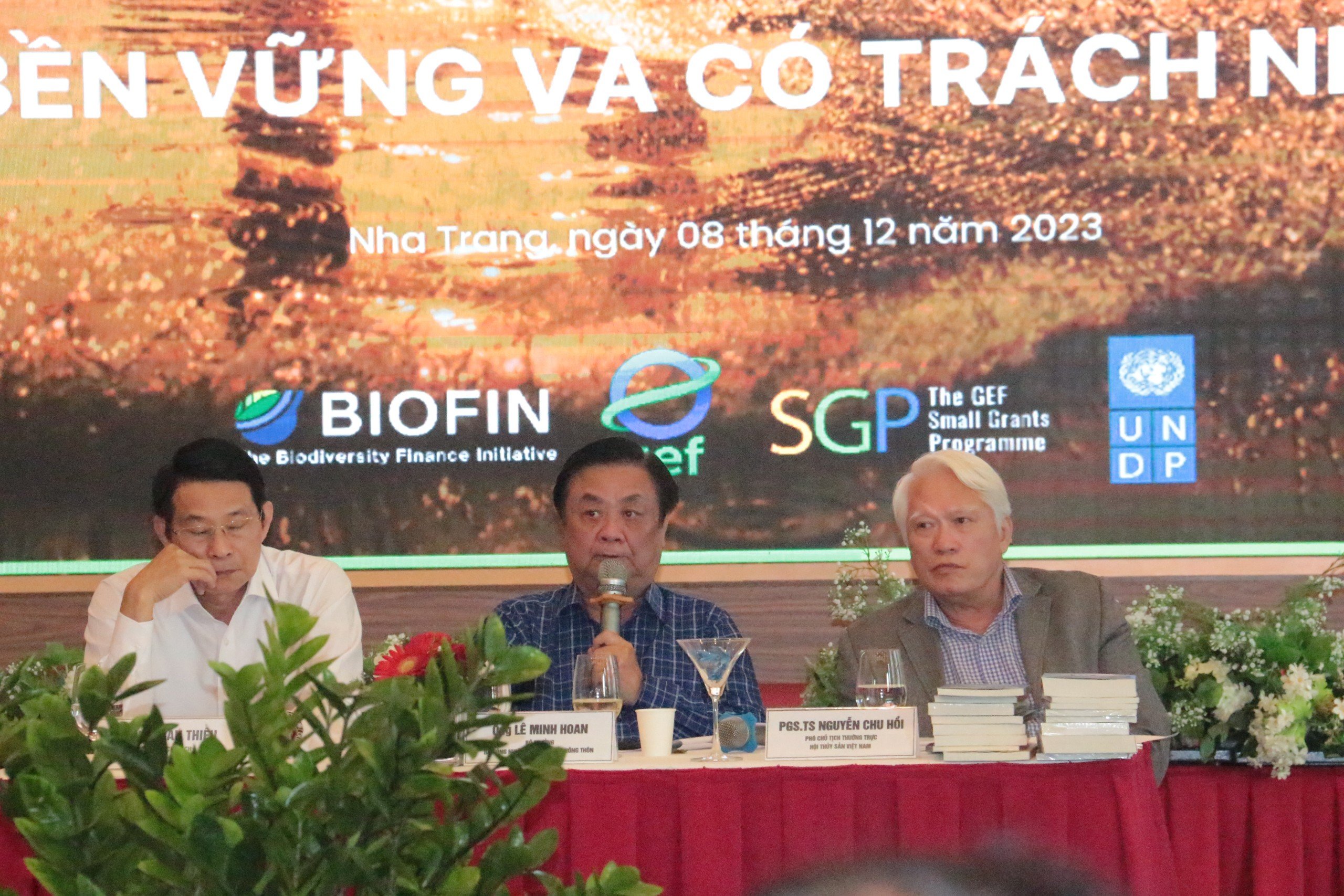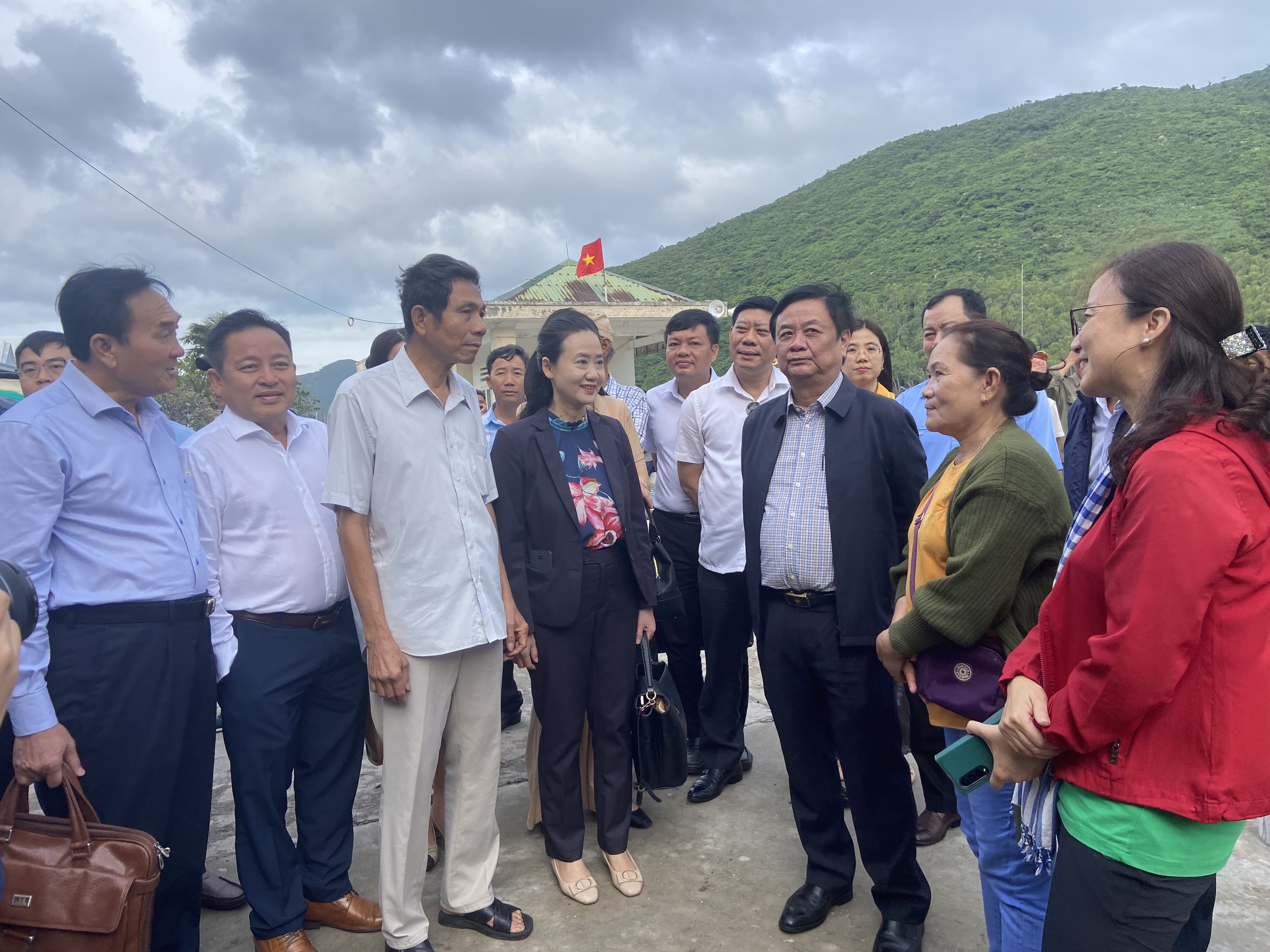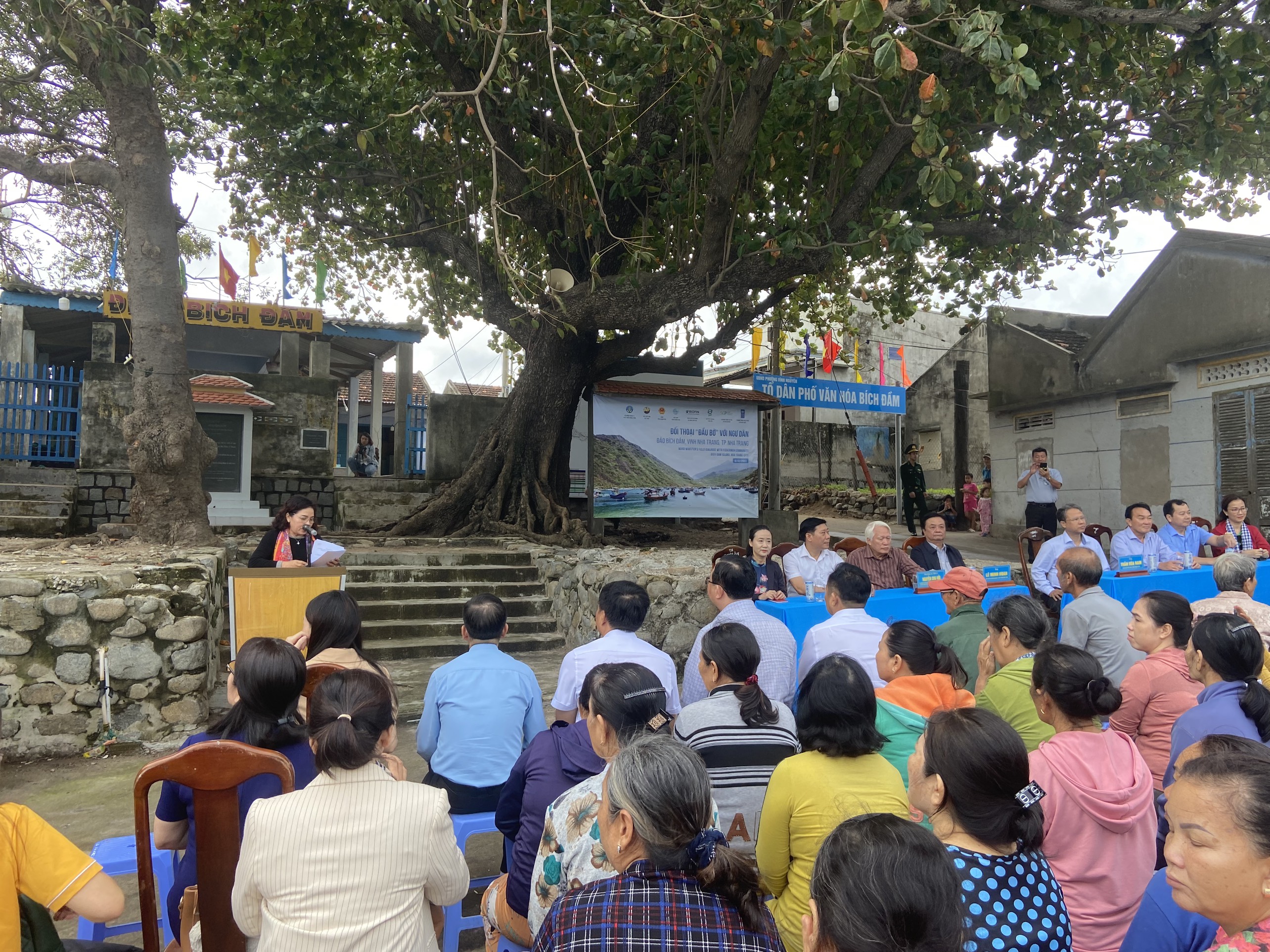Dialogue between the Minister of Agriculture and Rural Development and Fishermen and Associations on "Promoting Co-management for Sustainable and Responsible Fisheries"
December 8, 2023

Nha Trang City, December 8, 2023 - The Ministry of Agriculture and Rural Development (MARD) of Vietnam, in collaboration with the Vietnam Fisheries Association, with the support of the United Nations Development Programme (UNDP), the UNDP/GEF Small Grants Programme (SGP), the Biodiversity Finance Initiative (BIOFIN), and the Khanh Hoa Provincial People's Committee organized a dialogue between Minister Le Minh Hoan and the fishing community and fishery associations with the theme "Promoting co-management for sustainable and responsible fisheries." This was a special event, as it was the first time an "industry leader" had directly conversed with local communities at a practical and solemn event.
A "field-based" dialogue was held on the morning of December 8, 2023, at the site of the boat mooring area for fishermen of the Bich Dam Island residential quarter - where people live furthest from the shore in Nha Trang Bay. Here, the Minister visited the fishermen's boats and the mooring and storm shelter, learned about the work and life of the fishermen, etc. After that, the Minister took the time to discuss with the Bich Dam fishing community how to manage fishing in the area effectively and sustainably. On the afternoon of December 8, 2023, a "roundtable" dialogue at the Muong Thanh - Vien Trieu hotel emphasized the promotion and scaling-up of the "co-management" model to protect fishery resources; the role of fishermen, associations, and other stakeholders in the management of ports/fish landing sites in the country in the coming time. Through democratic dialogue, fishermen and stakeholders can reflect on the current local fishing situation, share community knowledge, propose solutions to problems in replicating co-management, and effectively manage ports and fish landing sites in Viet Nam.

Viet Nam boasts a vast sea, a long coastline, and a mosaic of islands, straits, coves, and bays. Viet Nam also has a rich marine biodiversity and fishery resources, sustaining the livelihoods of approximately 20 million coastal residents. Vietnam's fisheries operate as a commodity-producing, export-oriented economy, with a small-scale fishing industry evolving alongside commercial fishing (large-scale fishing). Market dynamics and the living environment of aquatic species within the supply chain significantly influence the quality and competitiveness of fishery products. The fisheries industry and marine activities, including exploitation, cultivation, and related services, have played pivotal roles in contributing to the national economy, expanding the export market, and safeguarding the security and sovereignty of the country's seas and islands. In the most recent year (2022), the overall production of aquatic products across the nation reached 9.06 million tons, marking a 3.1% increase compared to 2021. The export turnover of aquatic products in 2022 amounted to 11 billion USD, reflecting a 23.8% growth over the corresponding period in 2021 and surpassing the planned target by 22.2%, reaching a historic high.
In addition to its positive contributions, Vietnamese fishing faces several challenges and obstacles to developing a sustainable and responsible fishing industry amidst international economic integration, environmental issues, and maritime security concerns. Currently, climate change, marine pollution, unsustainable fishing practices, and the "yellow card" raised by the European Commission (EC) are all obstacles that are limiting the global competitiveness of Vietnamese aquatic products while also posing threats to the sustainable use of marine ecosystems crucial for the well-being of millions of residents. The Fisheries Law (2017) outlines a co-management mechanism for aquatic resources. Co-management aims to promote the participation of local fishing communities in the management, monitoring, and protection of marine areas allocated for exploitation and use. This approach seeks to enhance the quality of aquatic resources and improve the people's livelihoods. Co-management is also a stepping stone to promote autonomy and the positive contribution of the fishing community in the conservation and judicious use of aquatic resources. Co-management helps raise awareness and the responsibility of local people to protect aquatic resources and gradually implements the socialization policy. Strengthening the role and responsibility of the community in managing activities for the protection of aquatic resources proves to be an effective solution in mitigating conflicts of interest within the community and promoting the sustainable development of the fishing industry.
Before enacting the Fisheries Law (pre-2017), approximately 200 co-management models existed within the fisheries sector. From 2013 to 2016, 97 coastal fishery co-management groups were established in 25 districts and eight provinces, with over 13,000 fishermen participating. Following the implementation of the Fisheries Law, 27 community organizations have been officially recognized and granted management rights for the protection of aquatic resources in adherence to legal regulations. About 2,100 fishermen participate in co-management initiatives, covering an area of 117,000 hectares across nine coastal provinces and cities nationwide. Development partners have worked together with fishermen and local communities in these efforts, including DANIDA (Fisheries Sector Support Program (FSPS)), the World Bank (CRSD Project), and the United Nations Development Programme (through the UNDP/GEF-SGP Small Grants Program).

One of the earliest co-management models established after the 2017 Fisheries Law was in Ham Thuan Nam, Binh Thuan, supported by UNDP/GEF-SGP and continues to operate successfully. The success of Ham Thuan Nam is attributed to the thorough implementation of various steps, starting from the official establishment and recognition of the Co-management Group under the Fisheries Law. This includes the development of coordination mechanisms, exploitation plans, aquaculture, and protection strategies for aquatic resources, livelihood development plans, and the creation of community and revolving funds for livelihood development, among others. Despite encountering challenges in co-management efforts and sustaining viable livelihoods for local fishermen, the experiences and achievements of the model in Ham Thuan Nam, as well as the models that have been implemented, serve as tangible evidence of the imperative and significance of placing "people" at the core of activities related to aquatic resource conservation and livelihood development.
Currently, Viet Nam has strategically planned approximately 173 fishing ports, storm shelters, and numerous small and dispersed docks. These fishing ports and storm shelters are strategically distributed across all coastal provinces and central cities, spanning from river mouths along the coast to the islands, including Truong Sa district. The fishing ports are categorized into three groups: I, II, and III, each allocated with varying investment levels. These ports are directly overseen by coastal localities through the Port or Dock Management Board, funded primarily by government budget investments. The financial allocations primarily target infrastructure development, equipment acquisition, management apparatus, environmental protection measures, safety protocols, security enhancements, and other related aspects.
In addition to fulfilling the demands of industrial development, fishing ports and docks face challenges due to their large number and insufficient quality. The level of technological advance, management proficiency, infrastructure oversight, environmental protection systems, and water area management of these ports still need to improve on a regional and global scale. The absence of a public-private partnership model and mechanisms to incentivize the involvement and collaboration of fishing communities, wholesalers, private enterprises, and associations in the management process further compounds these challenges. Addressing the reality of managing fishing ports and docks, along with the requirements for the industrialization and modernization of fisheries, as well as the promotion of sustainable and responsible fishing practices, necessitates effective development solutions and "smart" management strategies for these facilities in our country in the foreseeable future. This is a new and difficult topic, and it is hoped that the "roundtable" dialogue between Minister Le Minh Hoan, fishermen, associations, enterprises, and other stakeholders will find ways to break through the "bottlenecks," enabling the breakthroughs needed for the development and management of fishing ports and docks in Viet Nam.
The contribution of local communities, technical support from professional agencies, and valuable resources from the private sector will help to maintain and enhance the co-management mechanism. Co-management remains an essential practice and policy. Therefore, the government needs to formulate policies that foster livelihood development and operate the Fund for the Protection and Development of Aquatic Resources, introducing the Aquatic Resource Protection Fee, among others, to ensure sustainable financial resources for co-management. At the same time, this approach allows for the experimentation of port/dock management models, engaging various stakeholders and aligning with the practices and cultural ethos of Vietnam's marine fishing community known as "vạn chài."
The dialogue is expected to provide the head of the agriculture and rural development sector with a valuable opportunity to directly hear the shared experiences, thoughts, and aspirations of those individuals who tirelessly devote their days and nights to the sea to establish a thriving life in their coastal hometowns while steadfastly working to preserve precious marine resources for the present and future generations. Co-management continues to be a sound policy not only for the protection of aquatic resources but also a lesson for ports and docks regarding "fishery co-management." Therefore, it is necessary to strengthen the effective operating mechanism further with technical and financial contributions from both state agencies and the private sector at the local level. This collaborative effort aims to continue yielding tangible results in protecting natural resources and enhancing fishermen's livelihoods. It also contributes to advancing a robust fishing industry grounded in the strength of the people, fulfilling international commitments and ensuring a sustainable legacy for future generations.
Media inquiries, please kindly contact:
Nguyen Huy Hoan, Deputy Editor-in-Chief, Vietnam Fisheries Magazine
Vietnam Fisheries Association
Email: haidang183@gmail.com
Phan Huong Giang,
UNDP Media and Communications Analyst, Climate Change and Environment
Email: phan.huong.giang@undp.org

 Locations
Locations



